How computers made art from bombs and weather machines
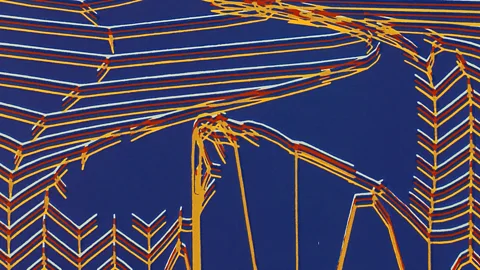 Ruth Leavitt
Ruth LeavittEarly computers were tools of science, industry and logic, but a few artists saw their potential to produce something beautiful. BBC Future explores what the machines created.
 Georg Nees
Georg NeesUntitled
In 1968, two exhibitions marked the international recognition of computer art. Cybernetic Serendipity: The Computer and the Arts toured London, New York, San Francisco and Washington DC, while Tendencies 4: Computers and Visual Research and an associated conference were held in Zagreb, Croatia.
To celebrate the 50th anniversary of the two events, the Victoria and Albert Museum in London and the Kunsthalle in Bremen are exhibiting some of the earliest computer artworks from several pioneers of the genre, including this one by Georg Nees.

Untitled
Georg Nees’ programs included commands to create random but methodical scribbles from pre-planned points of origin. The result was a gradual transition from order into chaos.
“There it was, the great temptation for me, for once not to represent something technical with this machine but rather something ‘useless’ geometrical patterns,” Nees told the ZKM in 2006.
 VG Bild-Kunst, Bonn
VG Bild-Kunst, BonnUntitled
For Wolfgang Baumer, the square was sacred. He sought to investigate the philosophy of the shape and create practical art through electronic experiments in design. He spoke fondly of Avignon, Provence, where he experienced a personal awakening upon studying the squares within the French city’s architecture. His own constructivist designs were created with plotters large computer printers that used a moving pen to draw on paper. Pens were attached to a bar that moved back and forth on a Y axis while the paper underneath glided over a roller across the X axis. The resulting lines were striking in their geometric precision.
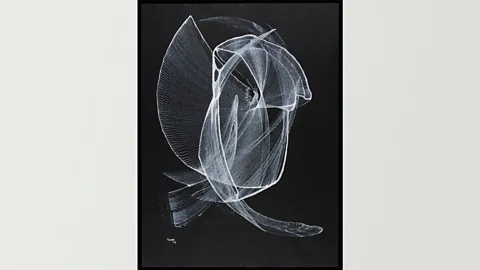 Victoria and Albert Museum, London
Victoria and Albert Museum, LondonUntitled
Nearly 20 years after the end of World War Two, Desmond Paul Henry found a new use for bombsight analogue computers, the machines used by bombers to calculate precise payload drops onto their targets. He modified their complex internal components to create interactive drawing machines. The screws, levers and pins in his inventions could be tweaked or loosened in real time, letting Henry fully customise his artwork over the course of hours or, in some cases, days.

Imaginare Architektur: Ferner Hafen
The designs in Otto Beckmann’s work are some of the least abstract in the exhibits. His Imaginare Architektur (“imaginary architecture”) collection uses a more figurative approach to mimic the silhouettes of urban city streets. Beckmann could adjust the settings within the computers built by his son Oskar in real time, allowing him to manipulate the shapes and lines with some control. Beckmann called his creative process a dialogue between man and machine.

Quadrate Werden Rot
Frieder Nake, a German mathematician, was one of the founding fathers of the art form – if there were a Mount Rushmore of computer artists, his head would be front and centre. From 1963 to 1969, he created an estimated 400 original works using a drawing programme he developed himself.
He coupled a SEL-ER65 computer from the Technical University of Stuttgart with a Graphomat drawing machine to produce remarkable, programmable art. By deliberately including random variables into his algorithms, he let the computer itself make ‘choices’ in the design. Thus, the outcome could never be fully predicted.
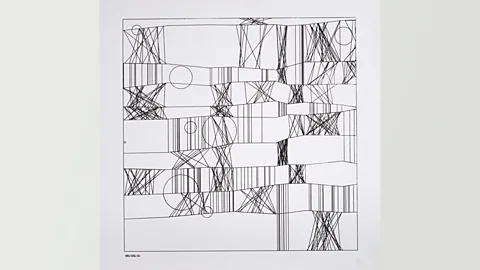 Frieder Nake
Frieder NakeHommage a Paul Klee
After establishing a groundbreaking portfolio of work, Nake had a change of heart and turned on his own creations. He spoke out about the consequences of using computers for art in a letter published by the Computer Arts Society in 1971, saying that it was wrong to use such technology for any other reason than helping the needy.
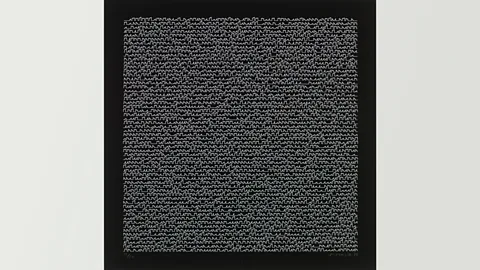 Victoria and Albert Museum, London
Victoria and Albert Museum, LondonP-122
In 1968, Manfred Mohr discovered that the Paris Institute of Meteorology was using an enormous computer to illustrate maps of weather patterns: exactly the machine he needed for his artistic experiments. He tinkered and researched for 11 years on nights when the meteorologists were away, and eventually created programmes that truly ‘thought’ for themselves.
The lines touching the horizontal base in his piece P-122 are associated with numbers zero through nine; the lines not touching it correspond to the alphabet A-Z. The letters and numbers were chosen by the computer, and thus create a completely random block of ‘text’.
“Through the machine, I become the super-version of myself,” Mohr told The Guardian in 2016.
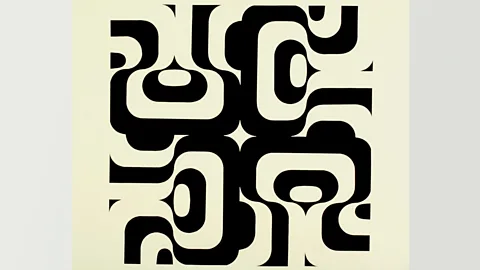 VG Bild-Kunst, Bonn
VG Bild-Kunst, BonnUntitled
Manuel Barbadillo was as concerned with his creative process as with the art itself. His work was defined by its extraordinarily smooth, repetitive shapes. Often, he would take the same design, rotate it 90 degrees, and re-paste it elsewhere. He obsessed for years over the intricacies within his artwork and sought to understand his own subjectivity in the process: why did he like some creations and not others when they were created with the exact same methods?
While seemingly flawless on their surface, a closer look at Barbadillo’s drawings reveals subtle imperfections. He enjoyed going over the algorithm’s designs with a second layer of paint to show his audience there was, in fact, a human creator behind them. He described the evolution of the computer as one from an “instrument of analysis” to a true “assistant in creation.”
 Herbert W Franke
Herbert W FrankePortrait Albert Einstein
The “Bildspeicher N” was an imaging device used in the field of diagnostic nuclear medicine to record radioactive antibiotics taken by patients. Because the device was connected to a scanner, researchers could process the images in different ways and view them live on a screen. Herbert W Franke adopted the sophisticated technology for his own ideas, manipulating standard photographs into indecipherable blobs.
“First, a black-and-white photograph of Albert Einstein was transformed into a blue grid pattern with 64x64 fields,” Franke wrote in a published essay. “The image information… was subjected to various geometric computing processes and extensive adjustment calculation, spreading of the 16 colours, and so forth. This led to increasing abstraction and simplification and ended in complete dissolution of the content of the image.”
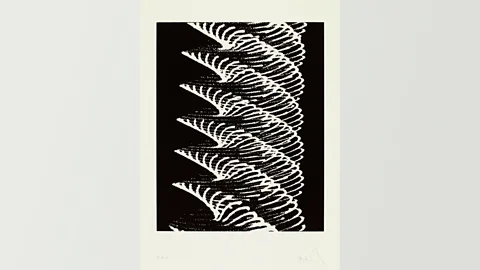
Elektronische Grafik
The artworks created using machines in this way prompted an important debate over whether leaving aspects of the design up to algorithms affected the artistic value of what was produced.
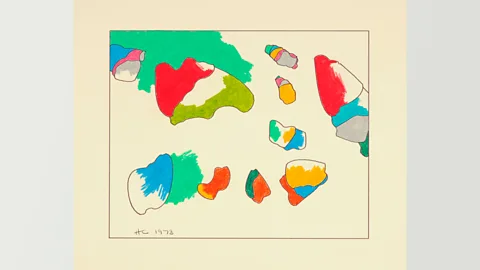 Harold Cohen
Harold CohenUntitled
Before Harold Cohen formally called himself a computer artist, he wrote a bit of code that controlled a little, robotic turtle. “Turtle” held a pen as it rolled across the floor, leaving behind smooth lines and marks. It was even equipped with a sonar navigation system that allowed it to ‘know’ the size of the paper and ‘’ where it had already been. Cohen would colour the designs by hand after the enclosed shapes had been drawn, rarely staying within the lines or following a strict pattern.
 Ruth Leavitt
Ruth LeavittHerringbone Variation V
Ruth Leavitt wanted to see how a regular pattern would distort by stretching it in different ways, so she designed her own program. The concept was “to explore and express the actions found in nature such as the forces of growing, flowing, and blowing”.
She began Herringbone Variation V with a straight grid composed of the letter Y, with every other row turned upside down. After cutting a space at the center, Leavitt pushed, pulled and twisted the design like a piece of chewing gum.
She was inspired by the computer’s power to process information and its ability to control other equipment, and it meant her creative process took precedence over the final product. “My art documented the way computers affect seeing, thinking, and constructing art and foretold of its impact on the culture at large.”
